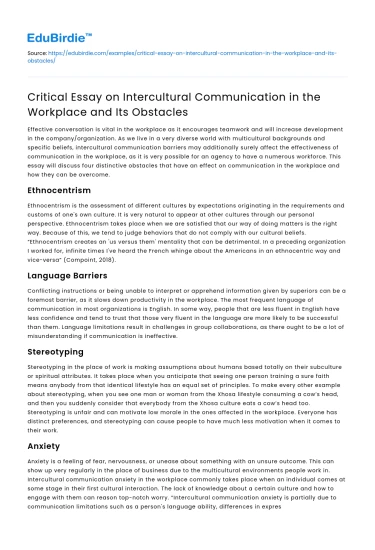Effective conversation is vital in the workplace as it encourages teamwork and will increase development in the company/organization. As we live in a very diverse world with multicultural backgrounds and specific beliefs, intercultural communication barriers may additionally surely affect the effectiveness of communication in the workplace, as it is very possible for an agency to have a numerous workforce. This essay will discuss four distinctive obstacles that have an effect on communication in the workplace and how they can be overcome.
Ethnocentrism
Ethnocentrism is the assessment of different cultures by expectations originating in the requirements and customs of one's own culture. It is very natural to appear at other cultures through our personal perspective. Ethnocentrism takes place when we are satisfied that our way of doing matters is the right way. Because of this, we tend to judge behaviors that do not comply with our cultural beliefs. “Ethnocentrism creates an 'us versus them' mentality that can be detrimental. In a preceding organization I worked for, infinite times I've heard the French whinge about the Americans in an ethnocentric way and vice-versa” (Compoint, 2018).
Language Barriers
Conflicting instructions or being unable to interpret or apprehend information given by superiors can be a foremost barrier, as it slows down productivity in the workplace. The most frequent language of communication in most organizations is English. In some way, people that are less fluent in English have less confidence and tend to trust that those very fluent in the language are more likely to be successful than them. Language limitations result in challenges in group collaborations, as there ought to be a lot of misunderstanding if communication is ineffective.
Stereotyping
Stereotyping in the place of work is making assumptions about humans based totally on their subculture or spiritual attributes. It takes place when you anticipate that seeing one person training a sure faith means anybody from that identical lifestyle has an equal set of principles. To make every other example about stereotyping, when you see one man or woman from the Xhosa lifestyle consuming a cow’s head, and then you suddenly consider that everybody from the Xhosa culture eats a cow’s head too. Stereotyping is unfair and can motivate low morale in the ones affected in the workplace. Everyone has distinct preferences, and stereotyping can cause people to have much less motivation when it comes to their work.
Anxiety
Anxiety is a feeling of fear, nervousness, or unease about something with an unsure outcome. This can show up very regularly in the place of business due to the multicultural environments people work in. Intercultural communication anxiety in the workplace commonly takes place when an individual comes at some stage in their first cultural interaction. The lack of knowledge about a certain culture and how to engage with them can reason top-notch worry. “Intercultural communication anxiety is partially due to communication limitations such as a person's language ability, differences in expression of emotion, and differences in verbal and non-verbal styles” (Spencer-Rodgers and McGovern, 2002).
Overcoming Intercultural Communication Barriers in the Workplace
In order to overcome these cultural obstacles in the workplace, start by means of identifying and perceiving them. This can be executed by searching how these barriers have an effect on the workplace. Supervisors/managers can begin by being accommodating to their workers, they can do this by inserting their religious holidays or cultural practices in their work schedule. Co-workers need to be willing to adapt or analyze others' cultures. It is additionally an exact thought to be open to attempting new things. This is obviously no longer required, but it can pave the way for a great relationship at work because the effort you put in leads to being appreciated.
Conclusion
Communication is a trade of information between two certain groups. Intercultural communication is vital in such a way that it lets in an understanding of different human experiences throughout social societies. To conclude this essay, intercultural communication boundaries need to be necessary of interest, as it is fundamental to make intercultural communication high-quality in the workplace.






 Stuck on your essay?
Stuck on your essay?

